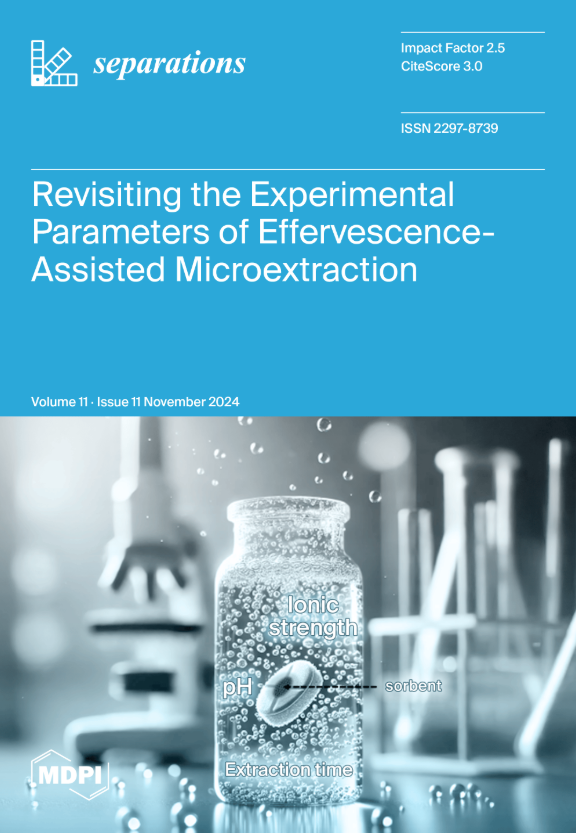Biochar-Based Adsorbents for Pesticides, Drugs, Phosphorus, and Heavy Metal Removal from Polluted Water
IF 2.5
4区 工程技术
Q3 CHEMISTRY, ANALYTICAL
引用次数: 0
Abstract
Water contamination is a ubiquitous issue for all countries and territories worldwide. Among others, pesticides, drugs, heavy metals, and phosphates play a special role in terms of pollutants due to their toxicity and large-scale applications in industrial and agricultural activities. In order to provide cleaner freshwater for the world’s population, two types of actions are required: preventing/limiting the pollution that might occur during our daily activities and decontaminating the already exposed/contaminated water sources. One of the key points in the decontamination process is to create as few as possible side effects with the solutions applied. For this reason, in the case of the mentioned types of pollutants but not limited only to them, the use of environmentally friendly materials is more than welcome. Biochar qualifies as one of these materials, and its field of applications expands to larger scientific and industrial areas every day. Moreover, it can be functionalized in order to improve its properties in terms of pollutant removal efficiency. This paper summarizes the most recent developments in the field of water decontamination using biochar or biochar-based materials in order to remove pesticides, drugs, heavy metals, and phosphates from contaminated aqueous environments. Also, the removal of phosphorus from wastewater using biochar is considered. This removal can be a key controlling factor for the wastewater, which is obtained as a residual of agricultural activities. Indeed, due to the excessive use of chemical fertilizers, eutrophication in such kinds of wastewater can be a serious challenge.生物炭基吸附剂用于去除污染水中的农药、药物、磷和重金属
水污染是世界上所有国家和地区普遍存在的问题。除其他外,农药、药物、重金属和磷酸盐因其毒性和在工业和农业活动中的大规模应用而在污染物方面发挥特殊作用。为了向世界人口提供更清洁的淡水,需要采取两种行动:防止/限制在我们日常活动中可能发生的污染和对已经暴露/受污染的水源进行净化。去污过程中的一个关键点是尽可能少地使用解决方案产生副作用。因此,在上述污染物类型的情况下,但不仅限于它们,使用环保材料是非常受欢迎的。生物炭是这些材料中的一种,其应用领域每天都在扩大到更大的科学和工业领域。此外,还可以对其进行功能化处理,以提高其去除污染物的效率。本文综述了利用生物炭或生物炭基材料去除污染水环境中的农药、药物、重金属和磷酸盐的最新进展。此外,还考虑了利用生物炭去除废水中的磷。这种去除可能是废水的关键控制因素,废水是作为农业活动的残留物获得的。事实上,由于化肥的过度使用,这类废水中的富营养化可能是一个严重的挑战。
本文章由计算机程序翻译,如有差异,请以英文原文为准。
求助全文
约1分钟内获得全文
求助全文
来源期刊

Separations
Chemistry-Analytical Chemistry
CiteScore
3.00
自引率
15.40%
发文量
342
审稿时长
12 weeks
期刊介绍:
Separations (formerly Chromatography, ISSN 2227-9075, CODEN: CHROBV) provides an advanced forum for separation and purification science and technology in all areas of chemical, biological and physical science. It publishes reviews, regular research papers and communications. Our aim is to encourage scientists to publish their experimental and theoretical results in as much detail as possible. There is no restriction on the length of the papers. The full experimental details must be provided so that the results can be reproduced. There are, in addition, unique features of this journal:
Manuscripts regarding research proposals and research ideas will be particularly welcomed.
Electronic files and software regarding the full details of the calculation and experimental procedure, if unable to be published in a normal way, can be deposited as supplementary material.
Manuscripts concerning summaries and surveys on research cooperation and projects (that are funded by national governments) to give information for a broad field of users.
The scope of the journal includes but is not limited to:
Theory and methodology (theory of separation methods, sample preparation, instrumental and column developments, new separation methodologies, etc.)
Equipment and techniques, novel hyphenated analytical solutions (significantly extended by their combination with spectroscopic methods and in particular, mass spectrometry)
Novel analysis approaches and applications to solve analytical challenges which utilize chromatographic separations as a key step in the overall solution
Computational modelling of separations for the purpose of fundamental understanding and/or chromatographic optimization
 求助内容:
求助内容: 应助结果提醒方式:
应助结果提醒方式:


